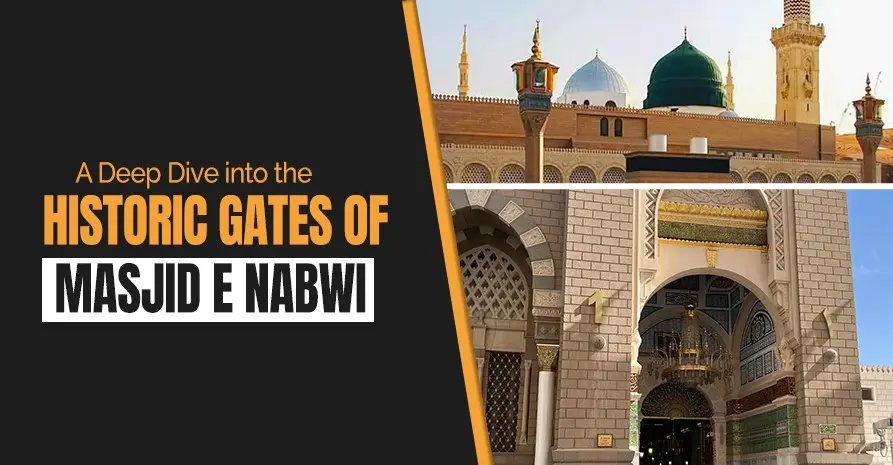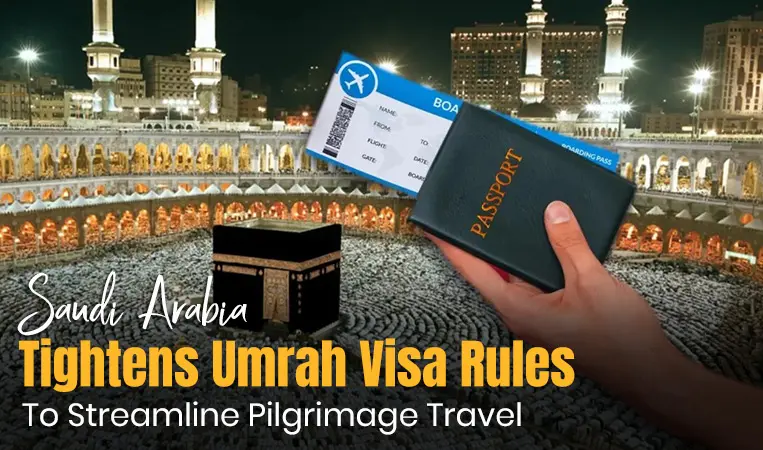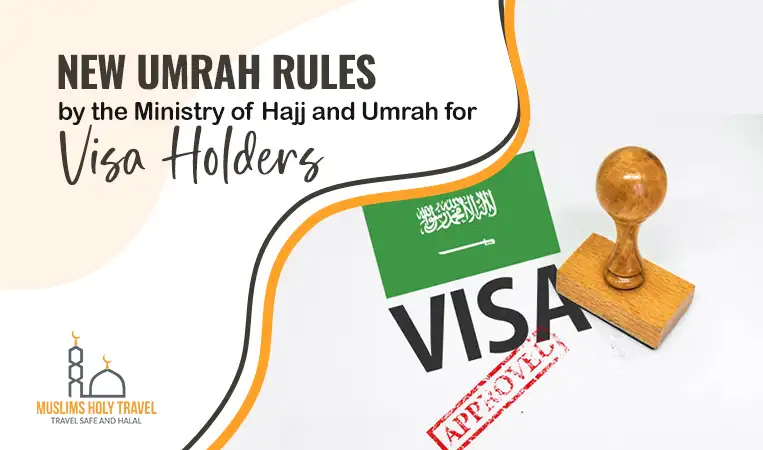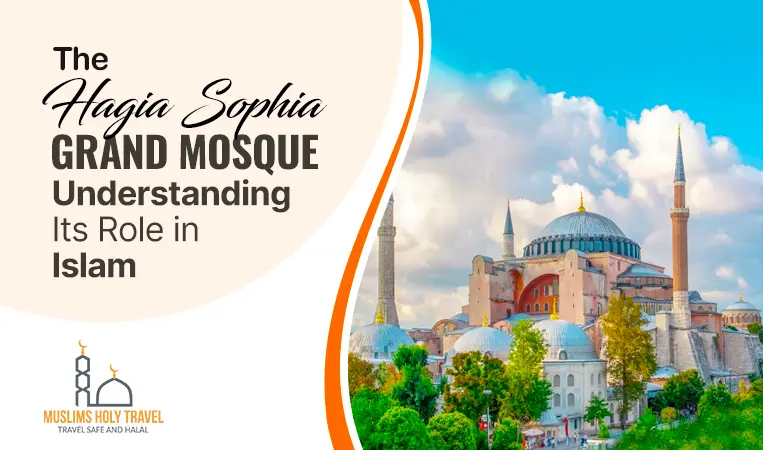
Masjid e Nabwi, also known as the Prophet’s Mosque, is the second most sacred place for Muslims. Located in Medina, it holds the distinction of being the second mosque built by the Holy Prophet (PBUH) himself. Since the time of its establishment, the mosque has undergone many renovations and extensions. The mosque covers an area of 59 acres (235,000 sq. mt) and has 42 gates to assist those entering the mosque.
Although visiting Masjid e Nabwi is not a part of Umrah rituals, Muslims never skip a chance to go there. A visit to the mosque during the Umrah trip fulfils the dream of almost every Muslim to pray there and see the burial site of their beloved Prophet Muhammad (PBUH) and his family. The capacity of this mosque is around 600,000, and it accommodates a large influx of prayers through 42 gates. These gates are located at strategic locations and have been built at different times. Each of the 42 entrances has its own importance and history.
In this blog, we will take you on an informative ride into the world of the 42 gates of Masjid e Nabwi. So, let’s start our journey.
Before we briefly explain all the 42 gates. Let’s find out which gates men and women can use.
Translating to the “door of peace”, the first gate of the mosque was built by Omar Faruq in 18 Hijri 640 CE. It is situated in the western wall of the mosque, and it has been relocated several times during various renovations and extensions.
Closest Underground Parking Sites: 2A and 2B
It is the second gate of the mosque, and just like the gate discussed above, it has been moved towards the west several times during extensions. The gate is small in size, and it was originally located near the fifth column of the pulpit.
Closest Underground Parking Sites: 2A and 2B
This is one of the most special entry points among the 42 gates, as it was installed by the Prophet (PBUH) himself. Originally, this door was in front of the house of Atiqa bin Abdullah bin Yazeed and was also known as Bab e Atiqa. Presently, this gate is also not located at its original location.
Closest Underground Parking Sites: 2A and 2B
As the name implies, this gate is named after the Hijrah of Prophet Muhammad (PBUH) from Makkah to Medina in 622 CE. It is a double-arched gate located on the left of the Bab ur Rahma. This gate was extended from two portals to four during expansions and renovations.
Closest Underground Parking Sites: 2A and 2B
It is a triple-arched gate that is located in the direction of the Quba village. The gate is situated on the southern side of the mosque and falls in the King Fahad bin Abdul Aziz block.
Closest Underground Parking Sites: 3A and 3B
This gate has no specific name and provides access to the escalator that leads to the mosque’s roof.
Closest Underground Parking Sites: 4A, 4B, 5A, and 5B
Named after King Saud bin Abdul Aziz, who commissioned the first extension of the mosque, this is one of the largest gates in Masjid e Nabwi. The gate consists of two large and five small portals. It is located on the southwestern corner of King Fahad’s expansion. This gateway also boasts one of the six tallest minarets of Masjid e Nabwi on the southern side.
Closest Underground Parking Sites: 6A and 6B
It is located on the western side of Masjid e Nabwi, between the King Abdul Majeed and King Saud gates.
Closest Underground Parking Sites: 6A and 6B
The gate is named after Wadi e Aqeeq, located along the western boundary of Medina. It is found on the western side of the mosque. The most important thing about Bab Ul Aqeeq is that it is surrounded by the homes of various prominent and close companions of the Holy Prophet (PBUH).
Closest Underground Parking Sites: 7A and 7B
This gate is named in honour of Ottoman Sultan Abdul Majeed. It is situated on the northwestern side of the mosque and was a part of the first Saudi expansion but was united in the mosque during the second Saudi expansion by King Fahd. Just like King Saud Gate, this gate has two large and five small portals. The gate’s minaret merges into Bab e Omar ibn Khatab of the Prophet’s Mosque.
Closest Underground Parking Sites: 7A and 7B
It is situated on the northwestern side of the mosque and offers direct access to the mosque’s library. The gate has 18 portals and is one of the busiest entry points for the mosque.
Closest Underground Parking Sites: 8A and 8B
The gate is located on the northern wall of the mosque and lies between Bab Malik Fahad (left) and Bab Umar ibn al Khattab (right). The gate is a single-portal entrance and is adorned with a verse from Surah Hijr.
Closest Underground Parking Sites: 9A and 9B
This gate is the main entrance on the north side of the mosque. It is named after King Fahad of Saudi Arabia, who was the king and the custodian of the two holy mosques in Makkah and Medina. This gate also holds the distinction of being the largest gate and the only one to have two minarets and seven portals. The gate is topped with five domes, and its minarets are also two of the tallest in the mosque.
Closest Underground Parking Sites: 10A and 10B
Bab Ohad is named after the famous valley where the battle of Ohod was fought between Muslims and the Quraish from Makkah. This is a smaller gate compared to the other gates in the mosque. The gate is installed with barriers that also act as foot traffic moderators used only at the times of intensive rush.
Closest Underground Parking Sites: 10A and 10B
This entrance point is named after the close companion of Holy Prophet (PBUH), Uthman ibn Affan, who also served as the third caliph. The gate is situated on the northern side of the second Saudi expansion near the northeastern corner. The gate has two large and five small portals and is one of the seven largest gates in the mosque.
Closest Underground Parking Sites: 11A and 11B
It is located on the eastern side of Masjid e Nabwi and holds the honour of being after a close companion and first cousin of Prophet Muhammad (PBUH). Just like the gate discussed above, it is also one of the largest and busiest gates in the mosque.
Closest Underground Parking Sites: 12 and 13
Bab Abu Zar Ghaffari is made up of gates number 31 and 32. The gate is named after Abu Zar Ghaffari, who was the fifth person to embrace Islam and a close companion of the Holy Prophet (PBUH). The gate is located on the mosque’s eastern side and in between Bab e Abdul Aziz and Bab e Ali.
Closest Underground Parking Sites: 12 and 13
Located on the southeast corner of the King Fahad expansion, this one is also one of the largest gates in the mosque. The gate stands tall with two minarets on each side and has two large and five small portals.
Closest Underground Parking Sites: 12 and 13
Just like gate 6, this gate is also used for accessing escalators leading to the rooftop of the mosque.
This gate faces the city of Makkah and is located on the southern side of King Fahad’s expansion. Bab e
Makkah is identical to Bab e Quba and has a triple-arched structure.
Closest Underground Parking Sites: 1A and 1B
This gate also has special status as it is named after Hazrat Bilal, the first Muezzin of Islam. It is a twin portal gate with a single arch over each portal. This is the gate used to enter Riyaz ul Jannah by pilgrims. The gate is located on the southern side of King Fahad’s expansion.
Closest Underground Parking Sites: 1A and 1B
Nisa means ladies and this gate was installed by Hazrat Umer, the second caliph specifically for ladies to enter the mosque. However, in recent times, the gate is also used by men to visit Riyaz ul Jannah.
Closest Underground Parking Sites: 1A and 1B
This is one of the most sacred and historically important gates in the mosque. It is believed that the Angel Jibrael used to enter through this gate to reveal the Quran to the prophet Muhammad (PBUH). Just like many other gates, it has also been shifted from its original location during expansions and renovations.
Closest Underground Parking Sites: 2A and 2B
This gate faces the Baqi ul Gharqad and is located close to the burial site of Prophet Muhammad (PBUH) and right opposite to Bab us Salam.
Closest Underground Parking Sites: 2A and 2B
It is a small gate located on the southern side of the mosque and also serves as an entrance to the Rooza e Rasool section. This gate is also known as Bab ul Janayez. The gate is mostly used by Imams, and it leads to Mehrab i Uthmani.
Closest Underground Parking Sites: 2A and 2B
If you also want to explore these gates, see them, and feel them with your hands, reach out to Muslims
Holy Travel right now. We offer a wide range of Umrah deals, starting from luxury Umrah packages to economic Umrah plans.



